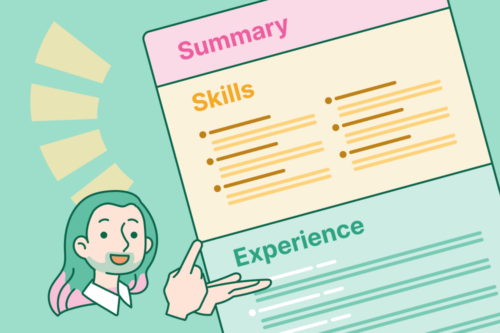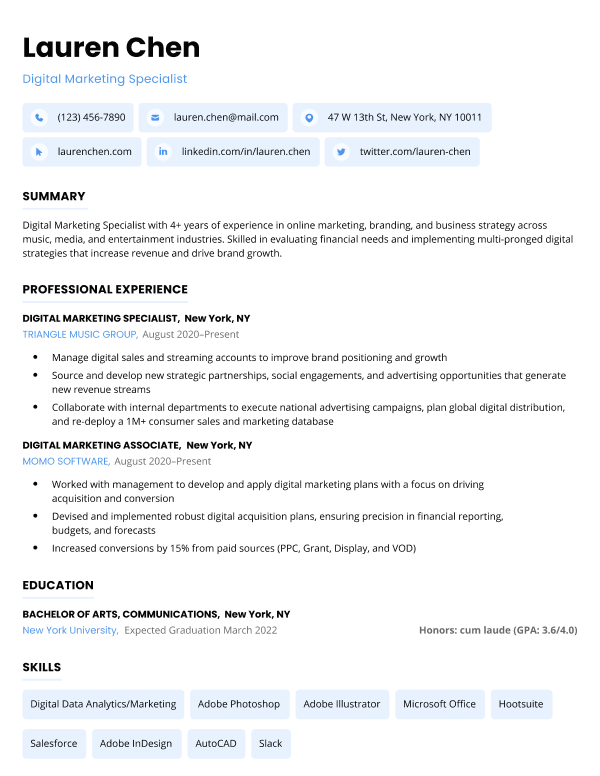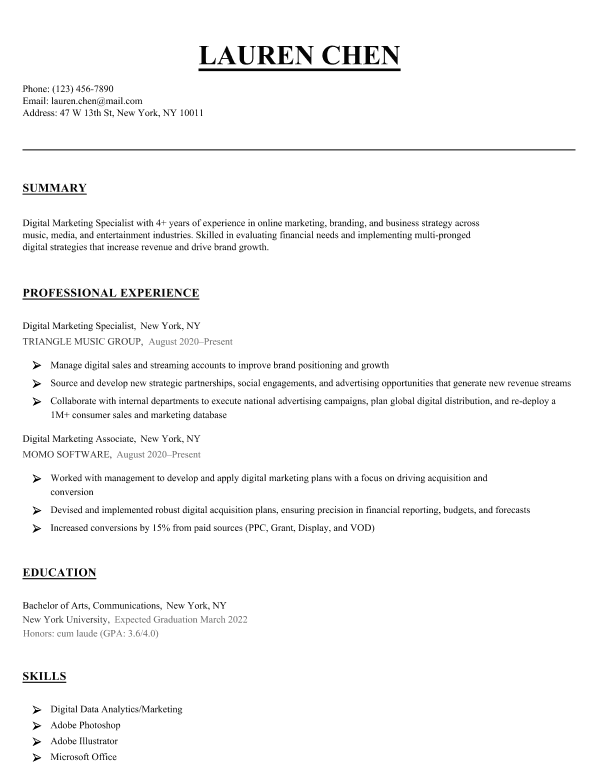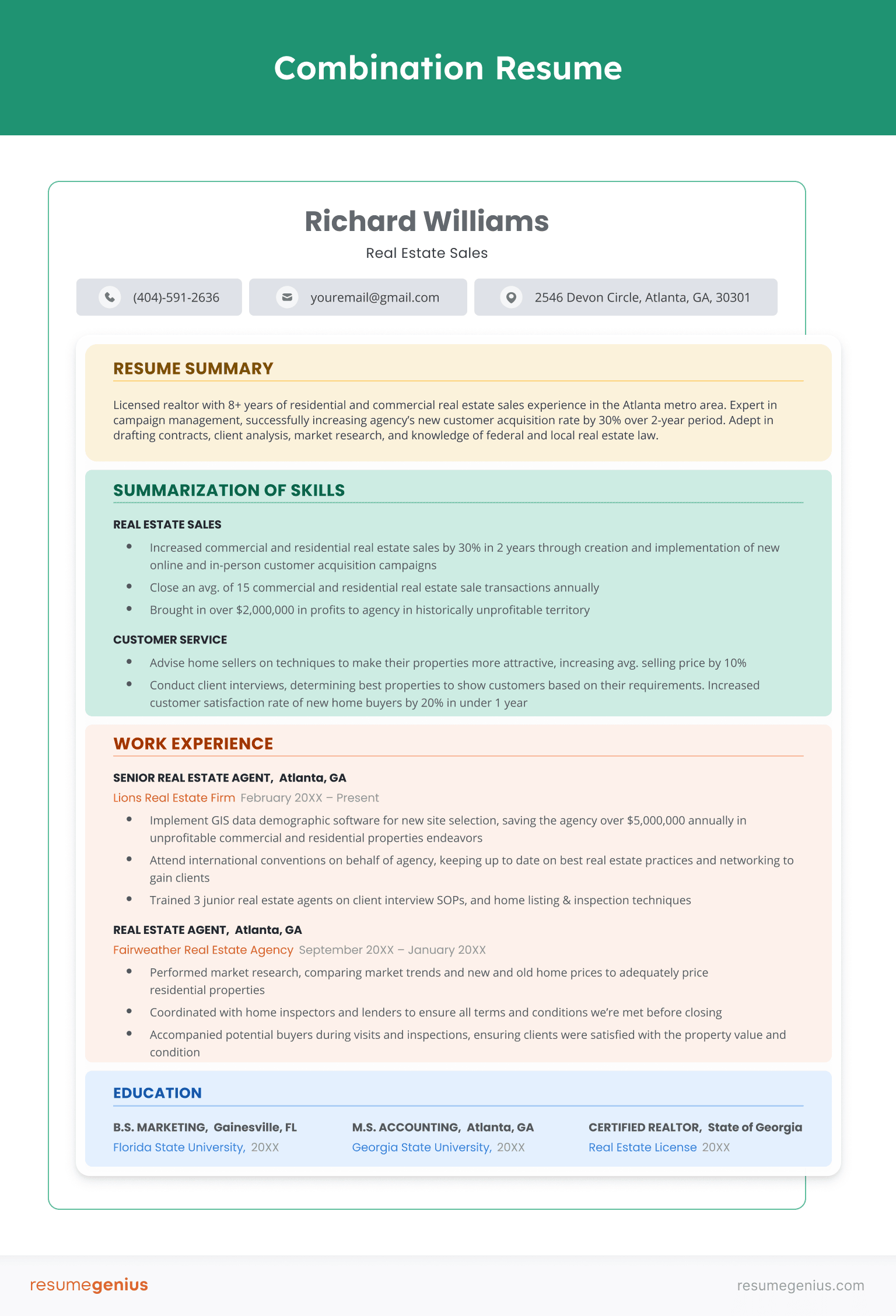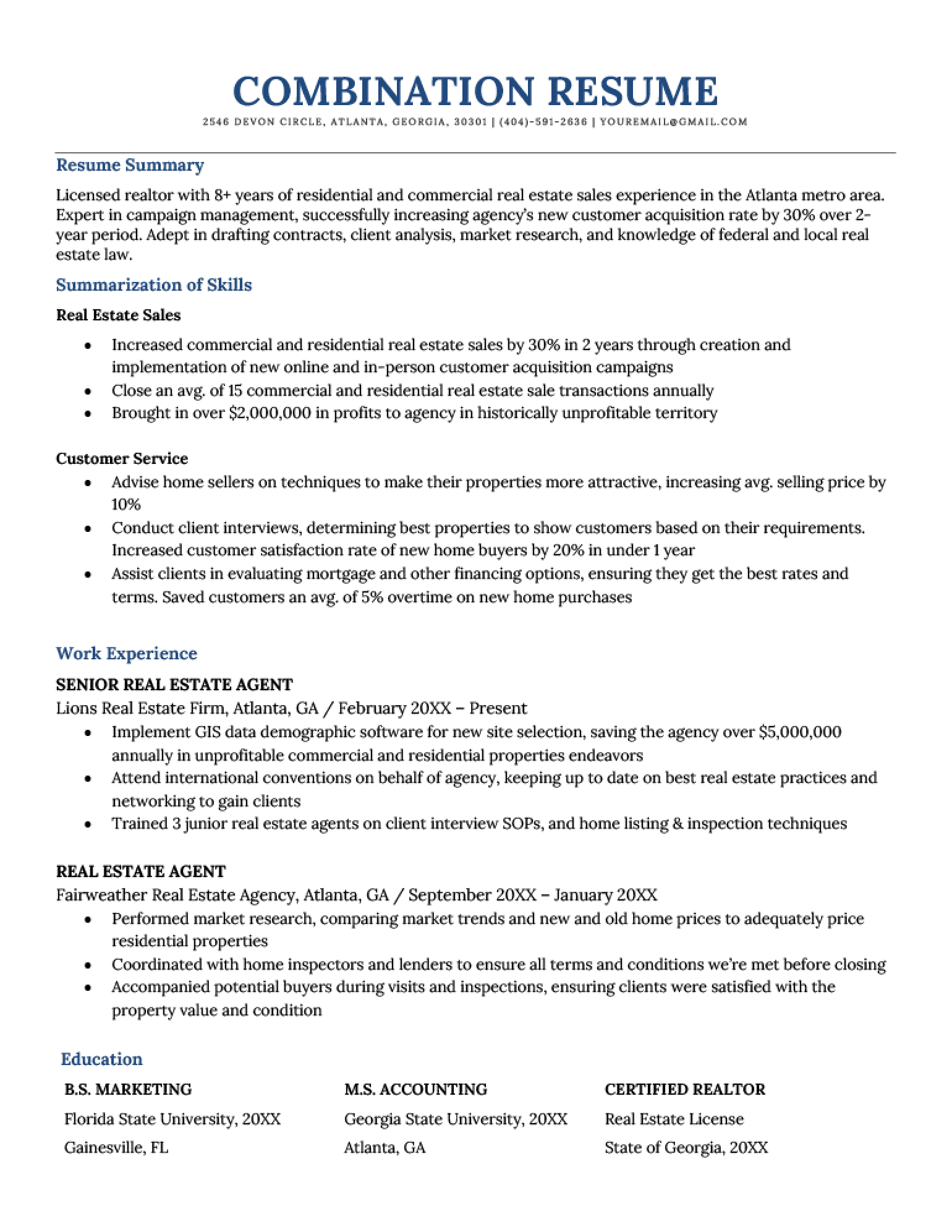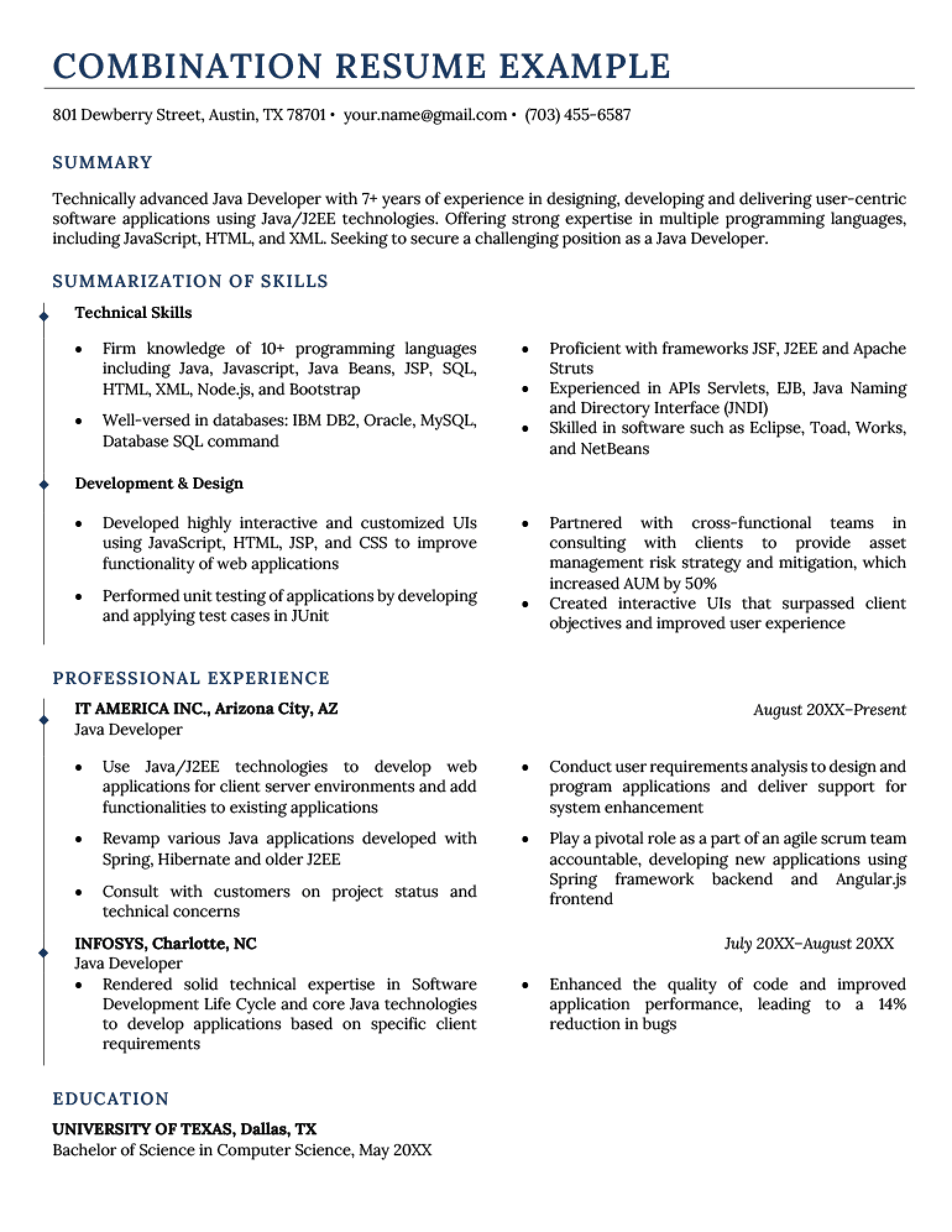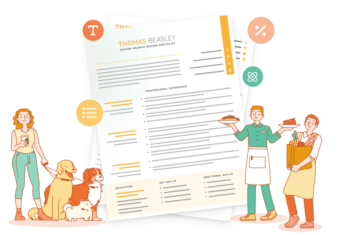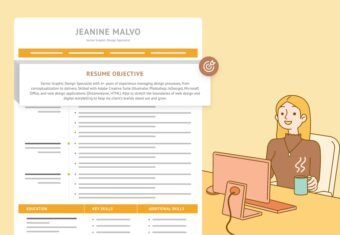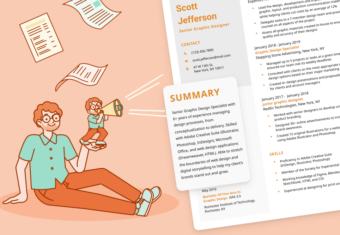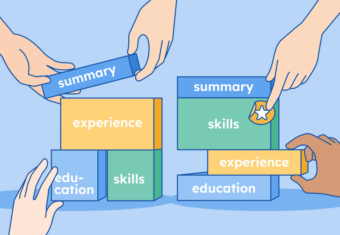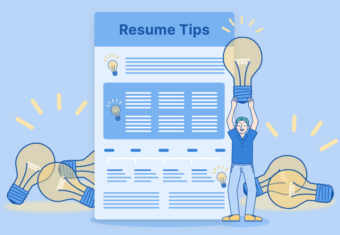The combination resume format is especially well-suited for highly-trained job seekers who want to place equal emphasis on their skills and work history.
If you fit this description, read on to learn how to create an excellent combination resume with our templates, examples, and HR-approved tips.
Our free-to-use resume builder can make you a resume in as little as 5 minutes. Just pick the template you want, and our software will format everything for you.
Combination resume template
To help speed up the resume writing process, here’s a combination resume template that you can easily copy-and-paste into Microsoft Word and fill in with your own information:
1. Resume Heading
FIRST AND LAST NAME
Email: youremail@gmail.com | Phone: 908 775 555 | Address: 122 Samuel Johns Road, NY 17101 | Linkedin: linkedin.com/in/yourprofile
2. Resume Summary
Dedicated [industry] professional with [# of years] years of experience. Seeking to apply my skills in [relevant skills] to fill the [position name] position. A diligent worker looking to help achieve [Company’s Name]’s goals of [company goals].
3. Relevant Skills
First Skill
- Include a bulleted list of accomplishments related to this skill
- Each bullet point should demonstrate your competency in this skill, using numbers if possible
Second Skill
- List any accomplishments or responsibilities that demonstrate this skill
- Be specific by mentioning the actual names of software or tools you’ve used
4. Work History
Most Recent Job Title
Employer Name / Location / Start Year – End Year
- Make a bulleted list of your responsibilities and achievements
- Unless this is your only job, stick to 3 to 5 bullet points
- Add hard numbers (such as percentages or dollar amounts) to your bullet points to illustrate specific accomplishments
Earlier Job Title
Employer Name / Location / Start Year – End Year
- List your relevant accomplishments from a job you held earlier
- Use past tense verbs to describe your responsibilities and duties
5. Education
Degree Name / Major
University, Location | Start Date – End Date
6. Additional Resume Section
- Here’s where you should add extra relevant information such as certifications or hobbies
- However, combination resumes dedicate a lot of space to your experience and skills, so it’s likely you may not have room for another section on your resume
Combination resume format
Here’s an example of what the combination resume structure looks like, with each section shaded with a different color:
When to use a combination resume
You should use a combination resume in the following situations:
- You’re making a career change and want to emphasize your transferable skills
- You have a specific, well-developed set of technical skills you want to highlight
- You’re a senior-level candidate with a diverse range of experience and skills
Combination resume examples
Below are a couple of combination resume examples to help you visualize what your finished resume should look like:
Example 1: realtor
Here’s an example of a combination resume for an experienced realtor:
Example 2: Java developer
Here’s another example of a combination resume made by an experienced Java developer:
How to write a combination resume
Need more guidance on how to write a resume that follows the combination format? Here’s a step-by-step guide to writing your own combination resume:
1. List your contact information
Include the following information at the top of your resume so employers can easily contact you:
- First and last name
- Professional email address
- Phone number
Additionally, consider listing your LinkedIn profile and address on your resume. These details are helpful for providing employers with more information about you, but are optional.
2. Add a resume summary
A combination resume needs to begin by emphasizing your relevant skills and accomplishments.
Starting with an achievement-based resume summary is the best way to start your resume off and show employers that you’re capable of doing the job.
Additionally, a resume summary is easy to adjust and target for each position, making it a great choice if you’re seeking employment at one or two places in particular or are applying to jobs that require different skill sets.
Here’s an example of a well-written resume summary:
Results-driven Business Manager with 5+ years of experience directing businesses with annual revenue ranging from $1M to $5M. Proficient in the overall development and execution of innovative strategies to generate millions of dollars in profit while forming effective and long-lasting partnerships. Looking to make an invaluable contribution to NexGen Solutions with an emphasis on fostering a culture of continuous improvement.
3. Group your skills by category
Combination resumes put a greater emphasis on your skills than a traditional chronological resume. As a result, your resume skills section should be listed before your experience section, and is structured differently.
When writing the skills section of a combination resume, choose two or three broader skills (such as team leadership or software development) that are directly relevant to the job you want. Underneath each skill, write three or four bullet points that illustrate your competency in this skill.
If you see an opportunity to quantify (add hard numbers to) your skills, then you should. Quantification strengthens your resume skills by giving employers concrete examples of your achievements.
However, your skills section and your experience section should share equal space on your resume, so be sure to keep your bullet points concise.
Here’s an example of a properly formatted skills section on a combination resume:
Technical Skills
- Firm knowledge of 10+ programming languages including Java, Javascript, Java Beans, JSP, SQL, HTML, XML, Node.js, and Bootstrap
- Well-versed in databases: IBM DB2, Oracle, MySQL, Database SQL command • Proficient with frameworks JSF, J2EE and Apache Struts
- Experienced in APIs Servlets, EJB, Java Naming and Directory Interface (JNDI)
- Skilled in software such as Eclipse, Toad, Works, and NetBeans
Development & Design
- Developed highly interactive and customized UIs using JavaScript, HTML, JSP, and CSS to improve functionality of web applications
- Performed unit testing of applications by developing and applying test cases in JUnit • Partnered with cross-functional teams in consulting with clients to provide asset management risk strategy and mitigation, which increased AUM by 50%
- Created interactive UIs that surpassed client objectives and improved user experience
4. Detail your professional experience (with bullet points)
The experience section on your combination resume should look similar to a chronological resume work experience section, but a bit shorter.
Whereas a chronological resume includes three to four (if you’re highly experienced) past positions, a combination resume should only feature your two most relevant positions to save space and keep your resume laser-focused. Use the present tense on your resume when writing the bullet points for your current position and the past tense when describing your past job duties.
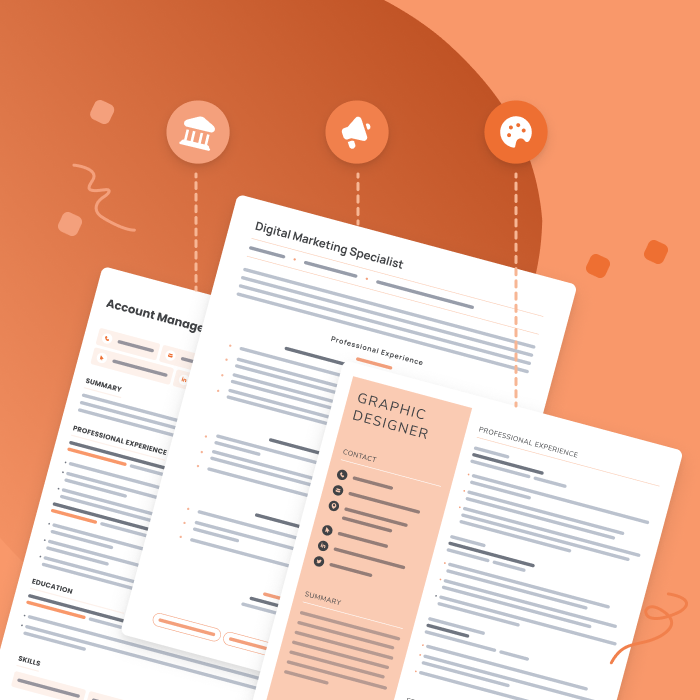
Resume examples for different industries
Not sure what your resume should look like? The best way to learn is by taking inspiration from resume examples written by other candidates in your industry.
Regardless of relevance, list your most recent job at the top of this section. Underneath each job, write two to four bullet points detailing some of your key duties and accomplishments.
Like your skills section, you should add numbers wherever possible to illustrate the impact you made at your previous job. This could include dollar amounts, time saved, or percentages.
Here’s an example of a well-written experience section on a combination resume:
IT AMERICA INC., Arizona City, AZ
Java Developer | August 2018–Present
- Use Java/J2EE technologies to develop web applications for client server environments and add functionalities to existing applications
- Revamp various Java applications developed with Spring, Hibernate and older J2EE
- Consult with customers on project status and technical concerns • Conduct user requirements analysis to design and program applications and deliver support for system enhancement
- Play a pivotal role as a part of an agile scrum team accountable, developing new applications using Spring framework backend and Angular.js frontend
INFOSYS, Charlotte, NC
Java Developer | July 2014–August 2018
- Rendered solid technical expertise in Software Development Life Cycle and core Java technologies to develop applications based on specific client requirements
- Enhanced the quality of code and improved application performance, leading to a 14% reduction in bugs
5. Note your education history
If you’re writing a combination resume, you likely already have an established career and don’t need to focus on your education history because it’s the least relevant part of your qualifications.
That means the education section of your resume should be as brief as possible and take up minimal space.
Additionally, if you have a bachelor’s degree or higher you should omit details about your high school because it’s not relevant to your professional qualifications.
Simply include your highest degree, school name, and graduation year. That’s it.
If you had a very strong GPA or received impressive Latin honors, you can also include these details. However, you should only do this if you have extra space on your resume, because your key selling points are your skills and work history.
Here’s an example of how to format the education section of a combination resume:
UNIVERSITY OF TEXAS, Dallas, TX
Bachelor of Science in Computer Science, May 2014
Click to rate this article
4.5 Average rating


